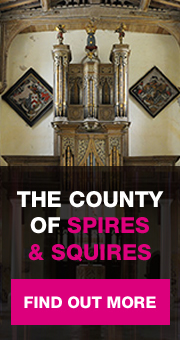A 13th century church considerably extended in the 14th century in the perpendicular style. Restored in 1870 by Slater and Carpenter with pew ends carved by the then incumbent, the Revd. J.H. Holdich. Monuments On the south wall stands the remains of a particularly fine memorial put up circa 1612. It is in the form reminiscent of an early 17th century fireplace. Resting on the “mantel” is an stone oval containing the sitter’s armorials, topped with an obelisk and to either side ribbons and tassels inlaid into the jambs. Kneeling in the “hearth” are Sir Henry Fowkes and his wife, separated by a prayer desk. I can find little about Sir Henry who died in 1612, save that he was clearly a property speculator trading the advowson of Godington in Oxfordshire in 1608, well, according to Google! This monument originally had a frieze of their children below and the whole thing would have been highly decorated only hinted at now by residual colour and the inlays. Further along the wall, to the other side of the entrance door, is the wall table to Sir George Tryon, a member of the family who owned the Bulwick Park estate since the 17th century (and whose descendants, the Conants, continue to hold it today). Sir George died with 300 of his men when his vessel, HMS Victoria collided with HMS Camperdown in the Mediterranean in 1893. This was a somewhat dismal end to an extremely distinguished career in which he saw service throughout the globe. I can recommend the well written entry in the National Dictionary of Biography. Other members of the family are also here, including Henry Tryon who had died at Sebastopol in 1854. The rather old fashioned, neo-classical wall tablet to Thomas Tryon, (1802-1872) was made by C.R. Smith whose workshop was in the Marylebone Road in London.
Please refer to the Glossary for any terms in the text that you are unfamiliar with.







